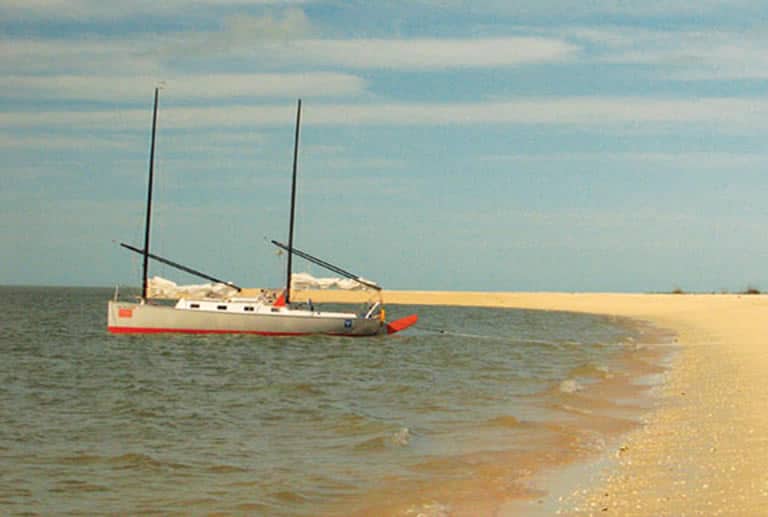The draft of a boat determines the depth of water the boat can be used in. You may be aware of shallow draft, on boats that can navigate very shallow waters, and deep draft, on boats that are used in deeper more turbulent waters, but what exactly is shoal draft?
Contents
What Is Shoal Draft?
Shoal draft refers to the draft of sailboats that have a shorter type of keel than a boat of similar size. The shorter keel allows the boat to pass through shallower waters than a full keel would. Shoal draft gets its name from the boat’s ability to better navigate the shallow waters found near shoals.
Most sailboats are fitted with a full length keel to give them better stability in deep water, especially when the water is turbulent. They are said to have a deep draft.
Because a a shoal boat has a shorter keel it can access shallower water and is said to have a shallower draft.
Because the keel length prevents the boat from accessing very shallow water, like a flat bottomed Jon boat, it is not a shallow draft vessel.
Likewise, because the keel is much shorter than a full-length keel it is not a deep draft vessel either. We can think of it as a cross-between the two types of draft.
Because a shoal draft boat is used in open ocean water but can also access water near sandbanks and shoals that form in coastal areas, these boats are referred to as shoal draft boats.
Although sailboats that can access shoals are often referred to as shallow water sailboats, every ocean-worthy sailboat will be a shoal draft boat as shallow water boats are rarely fitted with keels (one exception being the canoe).
Why You Would Need A Shoal Draft Boat
Shoal draft is almost always used to refer to the draft of a sailboat that is shallower than your would normally expect on an ocean-going boat of that size.
Shoal draft allows a sailboat to access the type of shallow waters that a deep draft sailboat would be unable to navigate.
This unique capability has both advantages and disadvantages as we will see.
Before moving on to the advantages and disadvantages of shoal draft though you may want to read the article about shallow draft vs deep draft to get a better understanding of how draft affects a boats performance.
Be aware that shoal draft is not the same as shallow draft.
For simplicity terms you can think of shoal draft as referring to a deep draft boat that has a shallower draft than normal.
The 2 main advantages of shoal draft
Below are the two key advantages that shoal draft offers:
- The ability to pass through shallower waters close to shore or submerged banks.
- Less likelihood of grounding or damaging your keel in shallow water areas.
a) Shoal draft allows a boat to pass through shallow waters
It should come as no surprise that a boat with shoal draft is better equipped to navigate shallower waters than a deep draft boat of similar size.
The boat’s capacity to pass through shallower waters is due to the shorter length of the boat’s keel.
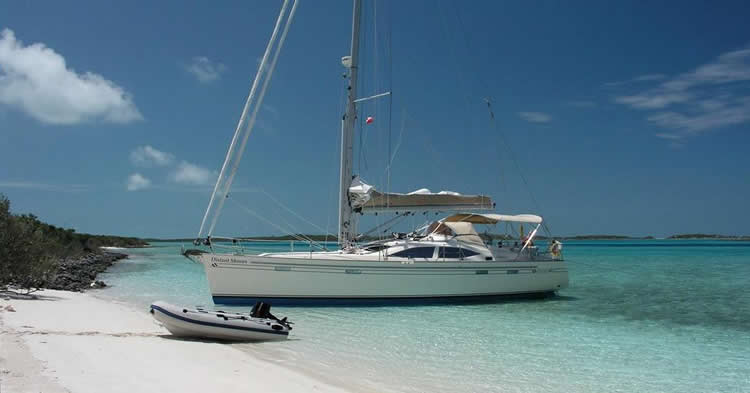
As the keel is the part of the boat that sits deepest in the water a boat with a shorter keel will be able to access water with less depth than a deep draft boat (with a longer keel) would need.
But, why would you need this capability?
b) Shoal draft means you are less likely to damage your keel
Well, if you regularly sail in waters that have shallow areas, or plan to cruise around shallow bodies of water where you run the risk of entering shallow areas by mistake, like the Florida Keys for example, then it would be best to get a shoal draft boat rather than a deep draft one.
Having a shorter keel, and thus a shallower draft, means you run much less risk of damaging your boat on the bed.
Passing through shoals or shallow waters with a boat that has a full keel, and thus a deeper draft, would likely result in the boat getting stuck (best case scenario). Or, the keel can become damaged (most likely scenario).
When this happens the bottom of the boat may also become so damaged that the boat starts to take on water and sinks (worst case scenario).
So, a shorter keel on a boat that usually has a full length keel gives the boat a shoal draft which allows it the ability to pass through shallower waters, such as shoals, more easily and safely.
The 2 main disadvantages of shoal draft
As with everything in life where there are advantages there are also disadvantages.
Below are the disadvantages of shoal draft:
- Not as stable in turbulent waters.
- Different righting moment.
i) Shoal draft boats are not as stable in turbulent waters
Shoal draft on a boat does give you the advantage of traversing through shoals easier but this comes at the cost of stability in turbulent waters.
Although a shoal draft boat is more than capable of ocean voyages it does not offer the same type of stability as a deep draft boat especially in challenging conditions.
The longer the keel, the more stable the boat is in turbulent water.
The shorter keel on a shoal draft boat means less stability in turbulent waters.
If you plan on taking your boat to deep choppy waters, you might be better opting for a deep draft sailboat rather than a shoal draft one for the extra stability it offers.
ii) Shoal draft gives a boat a different righting moment
This is another stability issue.
The righting moment of the boat is defined as the ability of the boat to maintain static stability.
With a shoal draft, the righting moment of the boat can be compromised because of the shorter appendage of the boat (the keel).
Usually, this is remedied by adjusting the ratio accordingly. This means that to correct the righting moment of a shoal draft boat the keel of the boat must be heavier.
Additionally by lowering or increasing the ballast it is possible to adjust the center of gravity of the boat, thus normalizing the righting moment.
Some boats do this better than others.
The 4 Types Of Shoal Draft Keel
As you know, the keel is the lowest part of a boat that is responsible for maintaining the stability of the boat while it is in the water.
As we have already learned a shoal draft keel is shorter than a full keel in order to allow the boat to navigate shallower waters.
There are several types of shoal draft keels found on boats (and a no keel shoal draft boat). They are:
- Fin keel.
- Wing keel.
- Bulb keel.
- Catamaran (no keel).
Let’s take a quick look at these keels now to see how they contribute to the shoal draft of a boat.
1. Fin keel
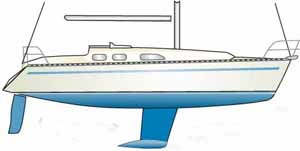
This is a variation of the standard deep fin keel but the draft is adjusted by reducing the keel length and profiling the keel to be able to add more weight to the ballast.
A lot of yachts are usually equipped with this or given the option to swap their full keel to this type of keel.
Another variation of this is a fin keel with a retractable centerboard.
This is usually used by people who take interest in sailing because the retractable center board makes it easier to avoid grounding.
2. Wing keel
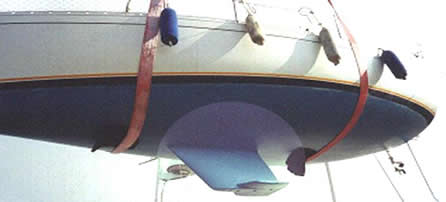
This type of keel is usually used on boats with shoal drafts because the wing keel provides a way to be able to reduce your boat’s draft.
Wing keels are usually found on yachts that regularly pass through shallower bodies of water.
This keel gets its name from its wing type protrusion at its tip (as seen in the image above).
A disadvantage to this is that wing keels tend to create a suction effect in soft mud bottoms slowing down the boat or even getting it stuck.
3. Bulb keel
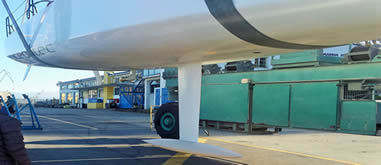
The bulb keel is a type of keel that usually has a high aspect ratio foil that has a ballast at the bulb.
A bulb keel is good when it comes to providing an efficient and effecting righting moment especially when your boat has a shoal draft.
Another good thing about this keel is the fact that it does not often get stuck in the ground but in the event that you do get stuck, it is relatively easy to free.
This makes the bulb keel one of the most suitable and common for shoal draft boats.
Bulb keels also come in centerboard designs allow it to be lifted thus giving the boat an even shallower draft.
4. Catamaran (no keel)
The Catamaran is an ocean -going vessel that has no keel therefore it is considered to be a boat with a shoal draft.
A catamaran does not need a keel to be able to stay stable, and not tilt, because of its multi-hulled design which is geometrically stabilized by the two parallel hulls and the wide beam it possesses.
If you would like to know about the different types of shoal draft boats available read our article what is a shoal draft boat.

